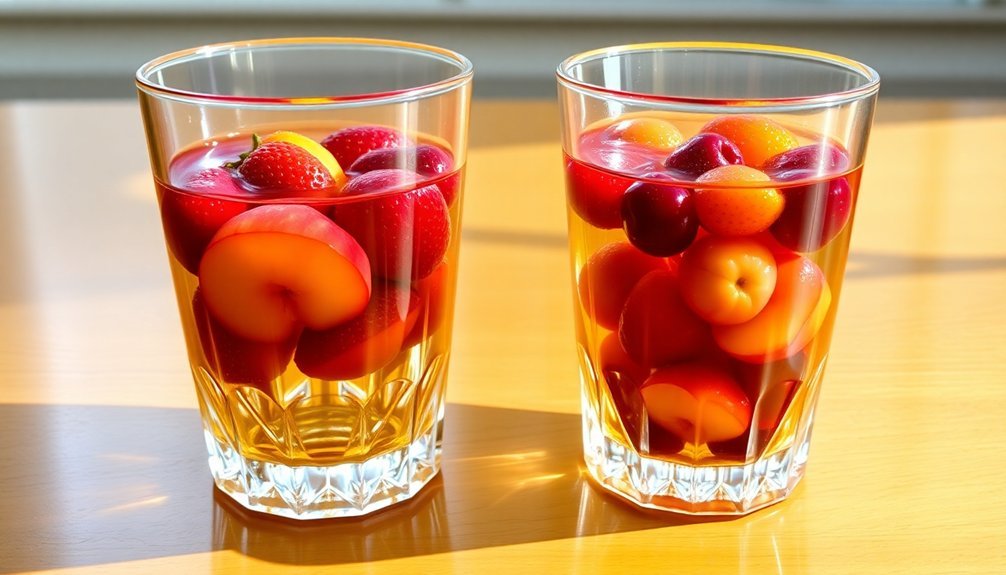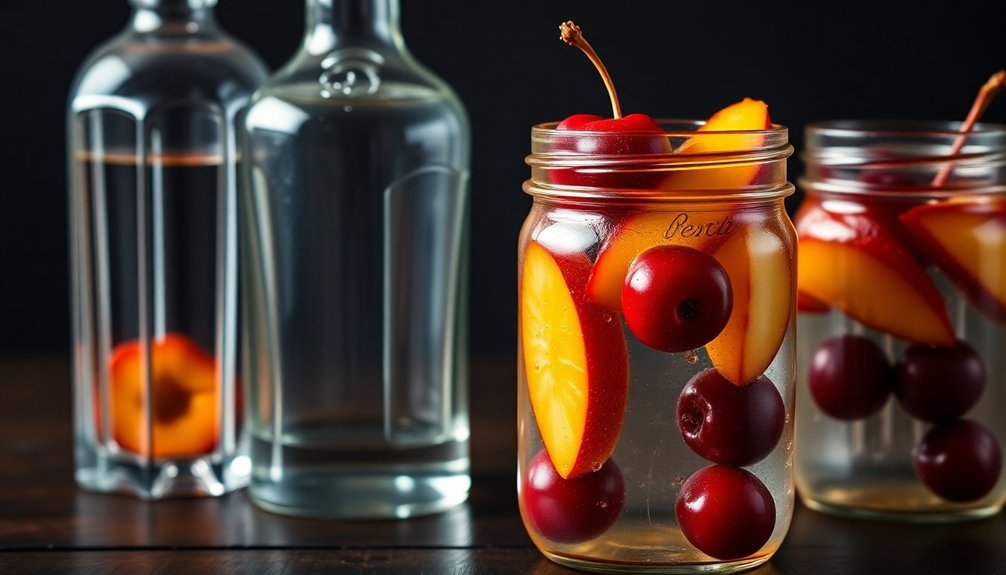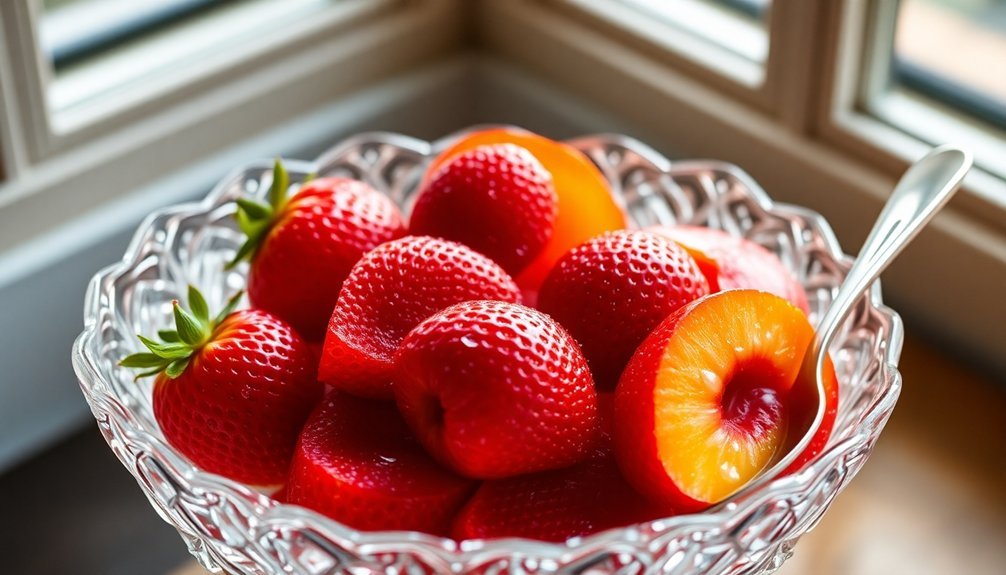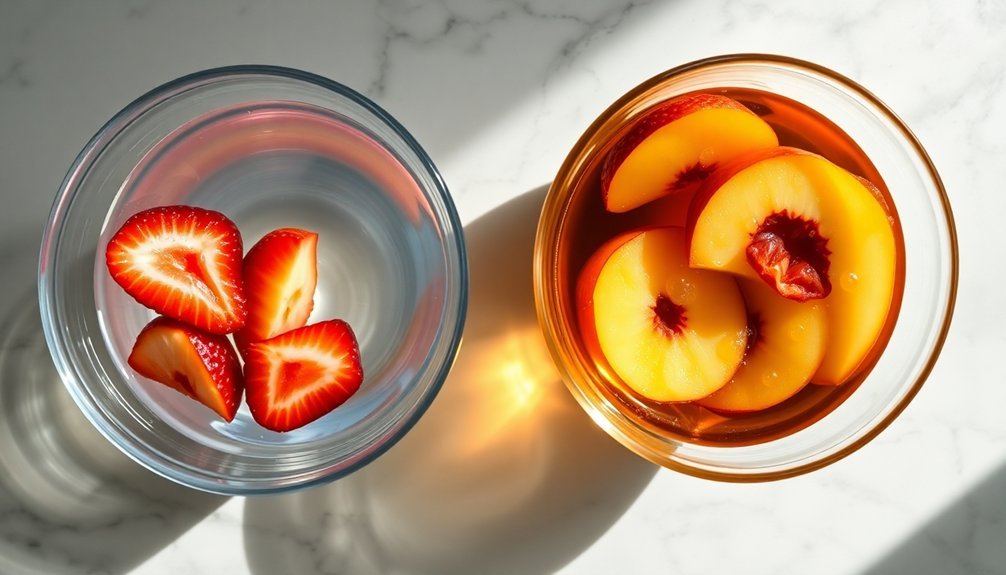Vodka and brandy keep your fruit fresh longer because of their high alcohol content, which acts as a natural preservative by inhibiting bacterial growth and slowing oxidation. When you fully submerge fruit in these spirits, the alcohol penetrates the skin and creates an environment where harmful microorganisms can't survive. You'll notice that while the fruit may change color slightly, it maintains its structural integrity and develops new flavor compounds over time. The quality of your chosen spirit matters – vodka offers a neutral base, while brandy adds complex notes to your preserved fruit. The science behind this preservation method holds even more fascinating secrets.
The Science Behind Alcohol Preservation

The process works best when you've fully submerged the fruit, as this guarantees complete preservation.
High alcohol content naturally prevents spoilage during storage.
You'll notice that the alcohol penetrates the fruit's skin, particularly in thin-skinned varieties, affecting both color and texture.
While it can cause some color fading, it's also working to slow down the decline of fruit firmness and reduce decay rates in a dose-dependent manner.
The result is preserved fruit that maintains its integrity while developing new flavor compounds.
Choosing Your Base Spirit
When selecting a base spirit for fruit preservation, you'll want to take into account both the flavor profile and preservation qualities of your chosen alcohol. Vodka stands out as a versatile choice due to its neutral flavor, allowing your fruit's natural taste to shine through without competing flavors. If you're new to fruit preservation, vodka's a safe starting point.
For fruits with robust flavors, you might consider brandy or other aged spirits. These work particularly well with peaches, cherries, and apples, as the spirit's caramel and toasted notes complement the fruit's sweetness. Brandy's complex flavor profile can add depth to your preserved fruits, especially when working with pears or spiced mixtures. High-proof alcohol is essential for better flavor extraction from your chosen fruits.
Don't overlook other spirits for specific fruit pairings. Tequila works wonderfully with citrus and pomegranate, while rum complements tropical fruits like mango and passion fruit. Gin's botanical profile pairs nicely with berries.
Whatever spirit you choose, avoid the cheapest options, as quality directly affects your results. Remember that your base spirit's alcohol content and inherent flavors will greatly impact your preserved fruit's final taste.
Best Fruits for Alcohol Preservation

Selecting appropriate fruits for alcohol preservation can make or break your final product. You'll find that stone fruits like plums, peaches, and apricots work exceptionally well, especially when they're slightly under-ripe. These fruits maintain their integrity while infusing spirits with complex flavors, though they'll gradually soften over time.
Berries offer another excellent option for preservation, with cherries and brandy being a time-tested combination. The long shelf life makes them particularly appealing for year-round enjoyment. While strawberries tend to become soft, they're perfect for muddling in cocktails. You'll get great results with raspberries, blueberries, and blackberries in either vodka or gin.
- Choose fresh, high-quality fruits at their peak ripeness
- Consider the fruit's natural sweetness to balance your preservation mixture
- Match your fruit selection to your intended use (garnish, muddle, or infusion)
- Pick fruits that complement your chosen spirit's flavor profile
Don't overlook alternative options like pomegranates and citrus fruits, which can create unique preserves.
If you're feeling adventurous, tropical fruits like pineapple and mango can add exotic elements to your preserved collection, though they're less traditional choices.
Remember that seasonal availability will influence your selection, so plan accordingly.
Storage Tips and Techniques
Proper storage dramatically affects the quality and longevity of your alcohol-preserved fruits. You'll want to keep your jars in a dark cupboard away from heat sources and light exposure, which can degrade both the fruit and alcohol.
While cool, dry places work well, your refrigerator is the ideal storage location after the initial steeping period.
You don't need to sterilize your glass jars, but they should be thoroughly clean before use. Make certain you're submerging all fruit completely in alcohol and securing the lids tightly to prevent contamination and evaporation.
Give the jars an occasional shake to help dissolve sugar and mix ingredients properly.
Your preserved fruits can last a year or more when stored correctly, though you might notice some flavor and color fading after the first year. The high alcohol content acts as a natural preservative, making spoilage rare.
You'll want to check your jars periodically for any unusual signs, but don't worry too much – some mixtures have lasted over a decade when refrigerated. Keep tasting periodically to ascertain quality, and remember that while the preservation may last indefinitely, the flavors will be best within the first year.
Using Your Preserved Fruits

The versatility of preserved fruits extends far beyond their jars. You'll find countless ways to incorporate these flavorful treats into both sweet and savory dishes. From topping your favorite desserts with "drunken fruit" to creating rich chutneys for winter meats, your preserved fruits can transform ordinary dishes into exceptional meals.
In baked goods, you can enhance flavor and moisture by mixing preserved fruits into cake batters, scone recipes, or bread doughs. For beverages, use the infused alcohol from your preserved fruits to craft cocktails, or add the fruit directly to smoothies and teas for an extra punch of flavor.
- Create savory fruit-based BBQ sauces for grilled meats by incorporating preserved fruits with traditional sauce ingredients.
- Transform basic cheesecakes and custards by topping them with stewed fruit mixed with preserves.
- Elevate your cocktail game by using both the fruit and its infused alcohol in creative drink combinations.
- Make spicy fruit chutneys to serve alongside winter dishes or as unique condiments for cheese plates.
Whether you're cooking, baking, or mixing drinks, your preserved fruits offer endless possibilities for enhancing both sweet and savory creations.
Frequently Asked Questions
Can I Reuse the Alcohol After Removing the Preserved Fruit?
You can reuse the alcohol after removing fruit, but you'll need to strain it thoroughly. Just filter through cheesecloth, adjust the alcohol concentration if needed, and check for any signs of spoilage before reusing.
Will Mixing Different Fruits in the Same Jar Affect Preservation Quality?
You can mix different fruits, but it's best to combine ones with similar textures. Firm fruits like apples pair well together, while soft fruits like berries should be grouped separately for ideal preservation.
Do Artificial Sweeteners Work Instead of Sugar for Preservation?
You can't rely on artificial sweeteners for proper preservation. While sucralose is USDA-approved, it won't protect fruit's texture and color like sugar does. Your preserved food will have shorter shelf life and quality issues.
Can I Add Spices or Herbs During the Preservation Process?
Yes, you can add spices and herbs during preservation! Try using cinnamon, cloves, or rosemary to enhance flavors. Just remember to use them sparingly as they'll intensify over time during the steeping process.
How Do I Know if the Preserved Fruit Has Gone Bad?
You'll know your preserved fruit has spoiled if you spot mold, discoloration, or sliminess. Watch for offensive odors, oozing liquid, or texture changes. If anything seems off, it's best to discard it.
In Summary
You'll find alcohol preservation is a practical way to extend your fruit's shelf life while adding complex flavors. Whether you've chosen vodka or brandy, remember to keep your preserved fruits in a cool, dark place and check them periodically. You can enjoy these boozy treats on their own or incorporate them into desserts and cocktails. Just be sure to label your jars with dates and alcohol content.





Leave a Reply